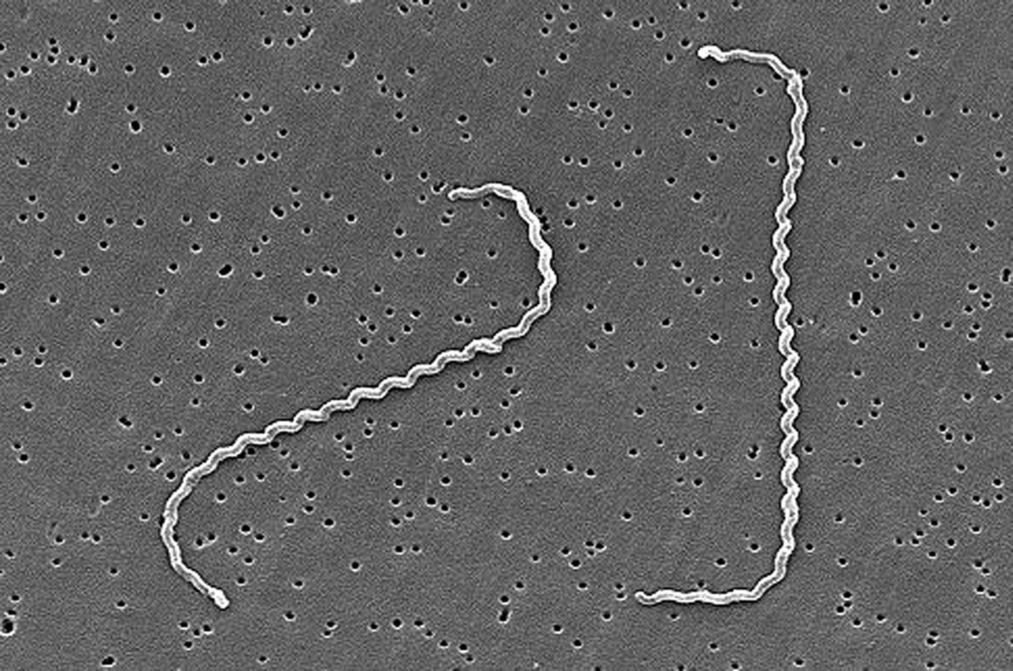Leptospirosis overview: Difference between revisions
(→Causes) |
|||
| Line 24: | Line 24: | ||
== Causes == | == Causes == | ||
Leptospirosis is caused by an infection with ''[[Leptospira]]''. Several species of Leptospira have identified and have been classified, genotypically, which include both pathogenic and saprophytic species. Among the pathogenic species, over 300 serovars have been identified by serotyping methods.<ref name="pmid22843698">{{cite journal| author=Forbes AE, Zochowski WJ, Dubrey SW, Sivaprakasam V| title=Leptospirosis and Weil's disease in the UK. | journal=QJM | year= 2012 | volume= 105 | issue= 12 | pages= 1151-62 | pmid=22843698 | doi=10.1093/qjmed/hcs145 | pmc= | url=https://www.ncbi.nlm.nih.gov/entrez/eutils/elink.fcgi?dbfrom=pubmed&tool=sumsearch.org/cite&retmode=ref&cmd=prlinks&id=22843698 }} </ref> | |||
== Differential Diagnosis == | == Differential Diagnosis == | ||
Revision as of 20:48, 9 March 2017

|
Leptospirosis Microchapters |
|
Diagnosis |
|---|
|
Treatment |
|
Case Studies |
|
Leptospirosis overview On the Web |
|
American Roentgen Ray Society Images of Leptospirosis overview |
|
Risk calculators and risk factors for Leptospirosis overview |
Editor-In-Chief: C. Michael Gibson, M.S., M.D. [1]
Overview
Leptospirosis (also known as Weil's disease, canicola fever, canefield fever, nanukayami fever, 7-day fever and many more[1]) is a bacterial zoonotic disease caused by spirochaetes of the genus Leptospira that affects humans and a wide range of animals, including mammals, birds, amphibians, and reptiles.[2] It was first described by Adolf Weil in 1886 when he reported an "acute infectious disease with enlargement of spleen, jaundice and nephritis". Leptospira was first observed in 1907 from a post mortem renal tissue slice.[3]
Though being recognised among the world's most common zoonoses, leptospirosis is a relatively rare bacterial infection in humans. The infection is commonly transmitted to humans by allowing fresh water that has been contaminated by animal urine to come in contact with unhealed breaks in the skin, eyes or with the mucous membranes. Outside of tropical areas, leptospirosis cases have a relatively distinct seasonality with most of them occurring August-September/February-March.
Recently, with the improved health and safety methods in the work place, more infections are occurring due to recreational activities rather than occupational exposure.[4][5]
Leptospires can survive for a prolonged period outside the animal host, especially in the environment favored by warm moist conditions with a neutral pH. Animal body fluids such as urine, semen and products of conception with pathogenic leptospires, pose a potential risk to humans through prolonged excretion of bacteria.Other less common mechanisms of transmission include direct infection from animal urine, human to human spread, sexual transmission and via breast milk.[6][7][8]
Historical Perspective
Adof Weil is the first physician described about the severe form of leptospirosis and the name Weil's disease is named after him in the year 1886. He also described the jaundice with splenomegaly, renal failure, skin rash and conjunctival suffusion.[9] Japanees scientists Kitamura and Hara named this disease as autumn fever and seven day disease in 1918.[10]
Classification
Leptospirosis is classified into anicteric and icteric form of leptospirosis based on the clinical presentation.
Pathophysiology
Causes
Leptospirosis is caused by an infection with Leptospira. Several species of Leptospira have identified and have been classified, genotypically, which include both pathogenic and saprophytic species. Among the pathogenic species, over 300 serovars have been identified by serotyping methods.[11]
Differential Diagnosis
Epidemiology and Demographics[edit | edit source]
Risk Factors
Natural History, Complications & Prognosis
Diagnosis
Treatment
Prevention
References
- ↑ Leptospirosis. National Organization for Rare Diseases (2015). http://rarediseases.org/rare-diseases/leptospirosis/ Accessed on July 28, 2016
- ↑ Leptospirosis. Centers for Disease Control and Prevention (2015). https://www.cdc.gov/leptospirosis/ Accessed on July 28, 2016
- ↑ Stimson AM (1907). "Note on an organism found in yellow-fever tissue." Public Health Reports 22:541.
- ↑ Philipp R, Waitkins S, Caul O, Roome A, McMahon S, Enticott R (1989). "Leptospiral and hepatitis A antibodies amongst windsurfers and waterskiers in Bristol City Docks". Public Health. 103 (2): 123–9. PMID 2786228.
- ↑ Philipp R, King C, Hughes A (1992). "Understanding of Weil's disease among canoeists". Br J Sports Med. 26 (4): 223–7. PMC 1479000. PMID 1490212.
- ↑ Ganoza CA, Matthias MA, Saito M, Cespedes M, Gotuzzo E, Vinetz JM (2010). "Asymptomatic renal colonization of humans in the peruvian Amazon by Leptospira". PLoS Negl Trop Dis. 4 (2): e612. doi:10.1371/journal.pntd.0000612. PMC 2826405. PMID 20186328.
- ↑ SPINU I, TOPCIU V; et al. (1963). "[MAN AS A VIRAL RESERVOIR IN AN EPIDEMIC OF LEPTOSPIROSIS OCCURRING IN THE JUNGLE]". Arch Roum Pathol Exp Microbiol. 22: 1081–100. PMID 14166972.
- ↑ Kiktenko VS, Balashov NG, Rodina VN (1976). "Leptospirosis infection through insemination of animals". J Hyg Epidemiol Microbiol Immunol. 21 (2): 207–13. PMID 987112.
- ↑ Adler B (2015). "History of leptospirosis and leptospira". Curr Top Microbiol Immunol. 387: 1–9. doi:10.1007/978-3-662-45059-8_1. PMID 25388129.
- ↑ Kobayashi, Yuzuru (2001). "Discovery of the causative organism of Weil's disease: historical view". Journal of Infection and Chemotherapy. 7 (1): 10–15. doi:10.1007/s101560170028. ISSN 1341-321X.
- ↑ Forbes AE, Zochowski WJ, Dubrey SW, Sivaprakasam V (2012). "Leptospirosis and Weil's disease in the UK". QJM. 105 (12): 1151–62. doi:10.1093/qjmed/hcs145. PMID 22843698.